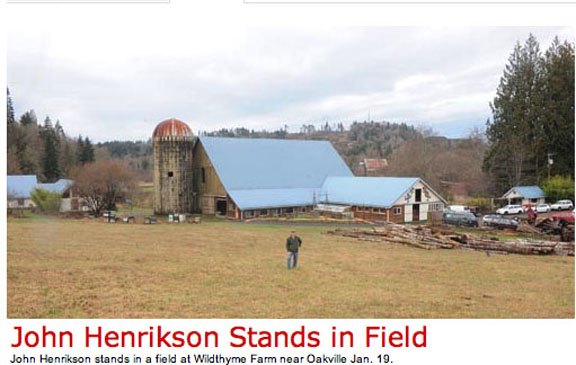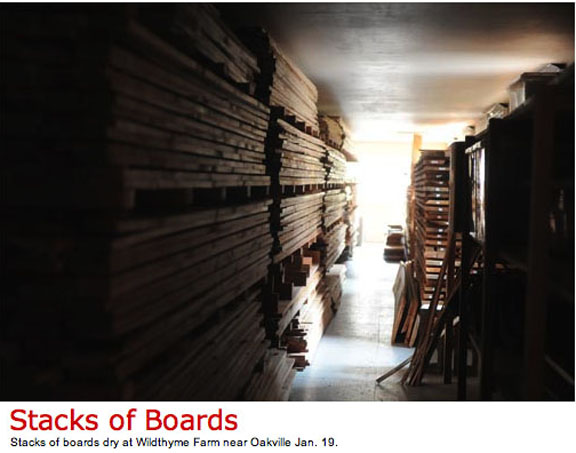











|
|
|

|
Having a Wild Thyme With Sustainable Farming
Oakville Farm a Mecca for Agroforestry
Posted: Saturday, January 23, 2010. By Dian McClurg / For The Chronicle
|
 |
OAKVILLE — John Henrikson works his “day job,” developing software in Olympia at night, because he needs daylight hours for farming. With his three brothers, Richard and Robert Henrikson and Jack Wight, John experiments with all sorts of farming techniques on their 150 acres just outside of Oakville. The brothers like to toss around words like permaculture, agroforestry and value-added production.
|
They sound like science terms, which is what Kirk Hanson, South Sound manager of Northwest Certified Forestry, says they are doing. “Agroforestry, which is what John is doing out there, is the science of creating forestry plantations that function much like an agricultural system, where you plant a variety of woody plants that can provide you with an annual and semi-annual product,” Hanson said.
|
Though John and his brothers, partners and friendly neighbors have been growing vegetables, herbs, hay, berries, timber and more at Wild Thyme Farm since 1987, the sustainable methods they are developing and using are beginning to make a lot of sense in today’s world.
|
 |
"Many other wood-product industries in Lewis, South Thurston and Grays Harbor counties are joining the ranks of people like John Henrikson and are experimenting with sustainable forestry practices. Local mills like Cascade Hardwoods in Chehalis, and Hampton Lumber in East Lewis County, have recently become certified through Hanson’s organization to mill lumber that is certified “green” by the Forest Stewardship Council. Wild Thyme Farm is just one of many small timber farms locally with the FSC certification", Hanson said.
|
Henrikson and his partners use various techniques to keep their timber-harvesting practices “green” and sustainable, including the use of low-impact harvesting machinery, but the main theme at Wild Thyme is multiple uses, Henrikson said. "Like most farmers around here, we have many things going on,” he said. “We try to have overlapping uses, layers.
|
|
Timber. ”The very definition of agroforestry is to design timber lots for multiple-crop uses. Along the creek that runs through the farm, for example, Henrikson has planted alder, ash, cherry, black walnut, cottonwood and Douglas fir trees. These trees restore the riparian habitat around the creek by providing shade and large woody debris for wildlife.
|
In the short run, Henrikson can take cuttings from the ash and cottonwood to start new trees. He can harvest the cherries and the walnuts. Mid-term, he can harvest slender trees for poles or make firewood. And, of course, in the long run he is growing high-quality lumber. When it comes to lumber, Henrikson specializes in value-added wood products. Value-added lumber is not a new idea in the wood products world, but it has become popular in today’s tough market. It’s a shift away from standardized, high-volume commodity products such as framing lumber and sheathing plywood toward the development of new products tailored to the needs of specific market segments. This boosts the product value to appeal directly to niche markets — where there’s less competition and more profit opportunity.
|
 |
Henrikson has his own mill on the farm. He keeps all the wood that would be considered “junk” for projects around the farm — including alder that sat too long. Though it wouldn’t sell well on the market, he’s made uniquely patterned trim with it.
|
Permaculture and Co-Op Farming. This idea of multi-use, layered farming is carried over into all aspects of Wild Thyme Farm. In the gardens and the fields, Henrikson has employed permaculture, which is a bit like a smaller scale version of agroforestry. The idea, again, is for everything to serve a purpose and for each garden or orchard or herb bed to serve many purposes — which may be to grow food, cultivate medicinal herbs, or benefit the wildlife, he said.
|
Down near Kundalini Stream, for example, Henrikson and his partners and neighbors have planted walnut trees mingled with blueberries and strawberries. Even the management and running of the farm is tailored for multiple uses, Henrikson said. Most of Henrikson’s neighbors and friends have their hands in projects going on at Wild Thyme. One neighbor is renting a space in the 100-year-old barn where Henrikson stores lumber. In exchange for use of the space, the neighbor is fixing the place up. Another neighbor cuts the hay. A friend from Olympia keeps his bee hives on the property.
|
Kirk Hanson, who works for the organization that provides “green” branding on lumber at Wild Thyme, has even worked with Henrikson on the farm. Hanson owns several acres of forest near Wild Thyme and has experimented with agroforestry practices with Henrikson.
|
New Layers — Eco-Education and Recreation. This idea of using the farm for multiple purposes and having friends and neighbors involved has led to the newest layer of use at Wild Thyme.
|
Henrikson has always kept an open-door policy for friends and family who wanted to use the farm for recreational or educational purposes. They’ve played host to many weddings and other gatherings. The brothers have just recently decided to make this newest use a formal part of the farm however. They have set up a conference room and are now bringing in workshops, conferences and retreats. Just this week they sponsored a Winter Wildcrafting workshop, where at least a dozen people drove out to Oakville to learn more about permaculture techniques and the harvesting of native herbs and plants for medicinal purposes.
|
Dian McClurg is a freelance writer living in Centralia. dlmcclurg@comcast.net.
|
|

